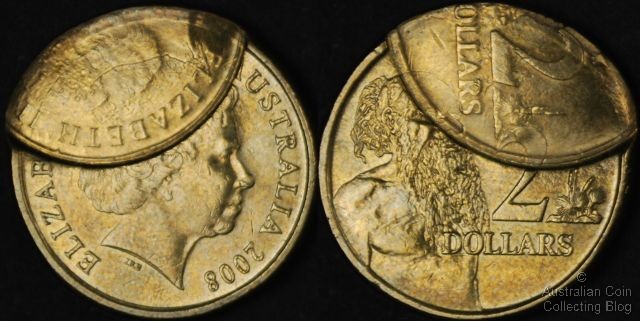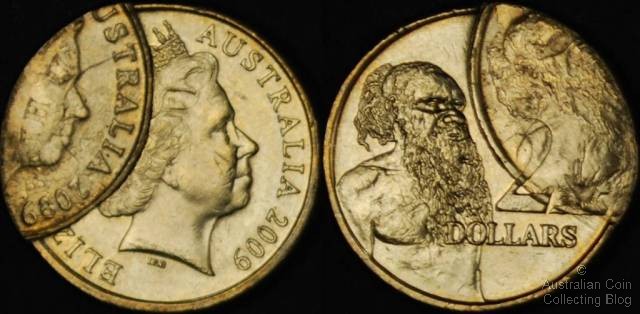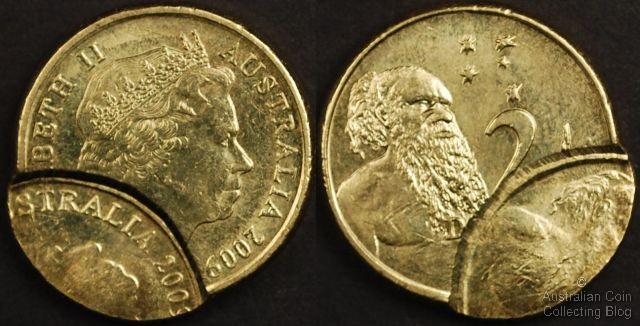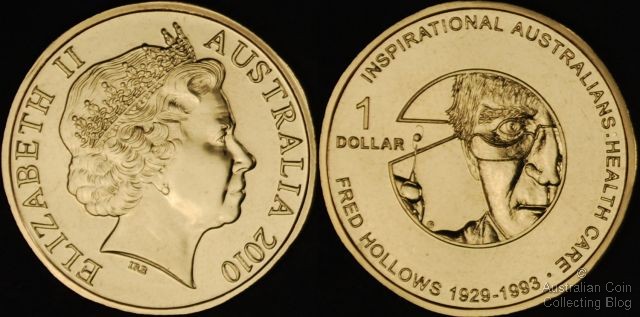July 2010 Archives
As published in the Australasian Coin and Banknote Magazine August 2010.
Written by the www.australian-coins.com/blog team with thanks to John Mulhall for getting it to print!
Lot 401 in Downies Auction 303 held in November 2009 was a double struck 2008 $2 error coin. The lot realised $1550 (plus buyers premium) and was in lovely almost uncirculated condition with the second strike overlaying the first by about 40%. As keen followers of the decimal error market this coin was the first double struck $2 that had become available in at least the last 5 years. We found the error to be remarkable given the scarcity of $2 coin errors, which we've found to be the least common error coin among all denominations in the decimal series. The reason for this isn't really known but possibly the answer lies in the lower mintages of the $2 coin.
To our surprise early this year another double struck 2008 $2 coin appeared on eBay being sold by a coin dealer from Sydney. That coin, graded as extremely fine or perhaps a little better sold for $865. An image of this coin can be seen in Figure 1. This coin was followed just a couple of weeks later by another 2008 double struck coin being sold by a well known Sydney dealer via mail order for $1000. We quickly contacted the dealer interested in purchasing the coin but it had sold in a very short time frame. So interestingly 3 of these double struck coins had appeared on the market in just 4 months!
Fast forward to March 2010 and yet another double struck $2 coin appeared on eBay being sold by the same seller as the first eBay coin. However, this one was a 2009 coin, had two clear dates of 2009 visible and was yet again graded as EF to AU. See Figure 2 for an image of this coin. This coin sold for just a touch over $800 and appears to be the best example sold to date. A 5th and (to date) final double struck $2 was listed by the same eBay seller/dealer in June 2010, this one was a similar grade to all the others and was a bargain for the purchaser, selling for just $455 (see figure 3).
 Figure 1
Figure 1 Figure 2
Figure 2 Figure 3
Figure 3What is a Double Struck Coin?
Double struck coins can take a few different forms, but the most common usually has a second strike that is rotated and off-centre from the first strike by a certain percentage. The double struck $2 coins we've discussed here are all off-centre around 60-70%. They've occurred when a coin is struck and then fails to clear the coining chamber completely before the next strike occurs. This results in a second strike partially obscuring the first. The coin may rotate as it partially exits the press resulting in different parts of the coin design overlaying the first strike. The second strike almost always results in the coin taking on an irregular shape (i.e. no longer round) because it is not constrained by the collar. This would mean that the coin would likely foul coin counting machines and vending machines while still weighing exactly same as a normal coin. From an error collectors point of view double struck coins with two visible dates are the most desirable examples.
Where did the Coins Come From?
We've heard a couple of theories about how these errors reached the collector market. The first is that the coins were 'mint sport' of the type similar to double obverse or double reverse coins minted in the 1970's. According to this theory the coins would have then been spirited from the mint and released onto the market. Upon showing one of the imaged coins to well known numismatists and error experts it was suggested that given the current setup of presses at the RAM and increased security to prevent theft from the mint that this first theory is more or less implausible.
The second (and much more likely theory) is that these errors occurred in the normal production process and were bagged up automatically by the mint's highly automated systems into mint bags before being released to security companies for rolling or bagging and subsequent distribution. We could then postulate that the highly irregular shape of the double struck coins caused them to be rejected by the security companies rolling or counting machines. The errors then somehow escaped the security company and ended up in the hands of a couple of dealers in Sydney. Given that 4 of the 5 coins to date have been sold by Sydney based dealers we can only assume that most of these errors have been sent to security companies in that area.
What Next?
Will any more of these errors appear? Clearly something has changed at the Royal Australian Mint to allow these errors to escape. Whatever has changed, it has only happened in the last year or two as we're aware of no earlier examples than the first two 2008 coins. Perhaps more $2 double strikes will appear and it will be intriguing to see if any other denominations might appear. A double struck $1 coin, for example, would be a holy grail for the authors, two of the keenest decimal error collectors we know!
Update June 2013: This has become one of the most common double struck decimal coin error with the majority being dated 2009. There must have been a faulty press at the Mint at this time. You'll be pleased to know that the authors have added that holy grail coin error to their collection!
 2010 Fred Hollows $1
2010 Fred Hollows $1To follow on from the Mary MacKillop one dollar (2008) and the Steve Irwin one dollar (2009) the Inspirational Australians dollar coin series in 2010 depicts Fred Hollows on an Australian one dollar NCLT collector coin. This series of coins recognises and celebrates individual achievements and commemorates unique Australians who have made an extraordinary contribution to our society.
Released by the Royal Australian Mint the reverse of this coin was designed by Vladimir Gottwald and was inspired by a portrait of Professor Fred Hollows by photographer George Fetting. The design depicts Hollows holding up an intraocular lens used on an Eritrean cataract patient. Fred, a skilled opthalmologist, was the inspiration for the Fred Hollows Foundation which has restored the sight of more than a million people around the world by implanting intraocular lenses into the eyes of cataract patients. His life's work (1929-1993) is continued by the Fred Hollows Foundation restoring sight and good health in those less fortunate countries. Through Fred's vision, the Fred Hollows Foundation helped establish factories in Nepal and Eritrea to produce these special intraocular lenses at cheaper cost. It operates in over 20 countries restoring sight to cataract patients for whom such surgery would normally be out of financial reach.
This encapsulated and uncirculated 25mm, 9 gram aluminium bronze one dollar was released at $12.95 issue price in a special informative card explaining the life and work of Professor Fred Hollows. His wife Gabi Hollows said "Fred would probably tell everyone to buy the coin, but then donate it to The Foundation". Fred was extremely passionate about his cause.
The obverse of this NCLT dollar is the standard effigy of Queen Elizabeth II by Ian Rank-Broadley. The mintage of this coin can be found in the 2010 mintage table.
It's the evening of Sunday 4th of July 2010 and the Melbourne ANDA Coin and Banknote Show for the year concluded at 5pm this afternoon. This year, like last year, the show was held at the Caulfield Racecourse in the members area of the main racecourse grandstand. Starting at 10AM on Saturday we arrived just a few minutes after official opening time and the queue to enter was quite long and it took us at least 10 minutes to enter. Once in, the show appeared to be layed out like last year (in fact some dealers were in the same location). It was quite difficult to actually get a seat at any dealers table because of the crowds of people looking for bargains. Actually the both of us were scratching our heads a little about the early crowd because there wasn't keenly sought limited issue for this show other than the proof 'M' mintmark 100 Years of Australian Coinage silver dollar released by the RAM. However, the corresponding issues at the other ANDA shows this year haven't exactly been super popular so we're pretty sure that wasn't why people were there so early.

The Royal Australian Mint Stand
After a couple of hours catching up with numismatic friends things settled down and we managed to start looking through some dealers stock books and hunting for that elusive bargain or the coin to fill a hole in a particular series we collect. The usual dealers were present at the show, we noted Peter Strich, Edlins, Tony Byrne, Klaus Ford, Prospect Stamps and Coins, Coinsearch.com, The Rare Coin Co., Downies, International Numismatics, VP Coins, and Steele Waterman Coins. Additionally there were a couple of dedicated stamp dealers there and a specialised banknote dealer. Apologies to anyone we've missed out of this list.
The Caulfield venue is a good one, with a snack bar where you can get snacks, drinks, and lunch, it's a little expensive but we found the food to of reasonable quality. There was plenty of space and tables to sit around to just take a break and have a coffee.
There's also enough room in the venue for a small audience to be seated and listen to free seminars which ANDA put on 3 times a day on various topics. Prominent people in the numismatic industry spoke about investing in bullion, gold, trading coins for wealth by Andrew Crellin and investing in rare coins and banknotes by Rob Jackman. We missed the talks (just too much to do and so little time) but given that you could listen in for free if you had a show entry ticket they seemed to be pretty good value (like most free things are!).
We took the time on Saturday to catch up with dealers that we knew and to talk coins, business, and generally have a gossip. We had also pre-arranged some meetings with collector friends including some internet forum members who we finally managed to meet face to face. It was great to be able to spend an hour around a table with fellow enthusiasts show off each others coins, discussing the merits of the coins, wondering how a particular error coin was made, and generally having a great time. Numismatics can be a lonely hobby and this opportunity was a great delight to the two authors and something we'll be trying to do again very soon.

A view of some crowded dealers' tables on day 1 of the show
Overall we felt that for this show the dealers seemed particularly friendly and happy to show us their stock and open up their cabinets for us to view closely which isn't always the case if they feel security might be a problem. But with ANDA hired security prowling the aisles and the tables we weren't aware of any problems arising even if the sign at the door stated anyone could be ejected at any time if their behaviour became unruly.
A particular delight was meeting again with Ian McConnelly, an authority on varieties and error coins who writes regularly for the Australian Coin and Banknote Magazine and has just released the second edition of the Renniks published book "Australian Pre-decimal Coin Varieties" which he kindly autographed for us. Whilst we were at it we got Steele Waterman of Steele Waterman Coins and president of ANDA to autograph the article he wrote for the current CAB magazine (July 2010 issue) about his experiences in the Victoria Police with stories about counterfeit banknotes. And on a roll we bought a copy of Andrew Crellin's "The Colonial Coinage of Australia" and got him to sign that too. We certainly were a pair of signature chasers this weekend!
Returning for the second day on Sunday it was a much quieter event. With still plenty of tables to rummage through and dealers to talk to we're not sure where the last 6 hours of the show actually went. We had our heads in albums, cabinets and boxes of 2x2's. About an hour before the end of the show those dealers who had to travel afar packed up their goodies and headed off. We were done by then, totally coined out.
As always it was a great thrill to attend an ANDA Coin and Banknote show and this one was particularly enjoyable because of the friendly dealers and fellow hobbyists who we managed to catch up with. We'll be making an effort to attend this show again next year and we hop we have just as much fun.


